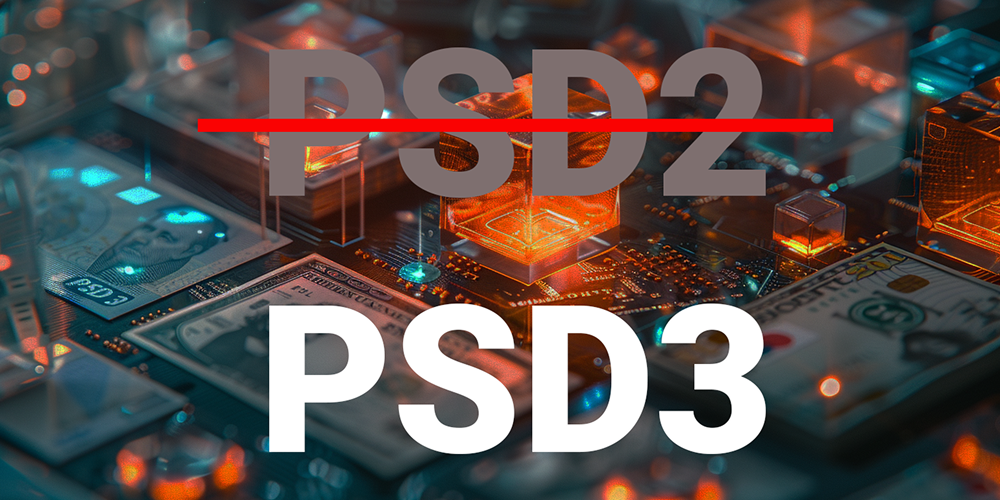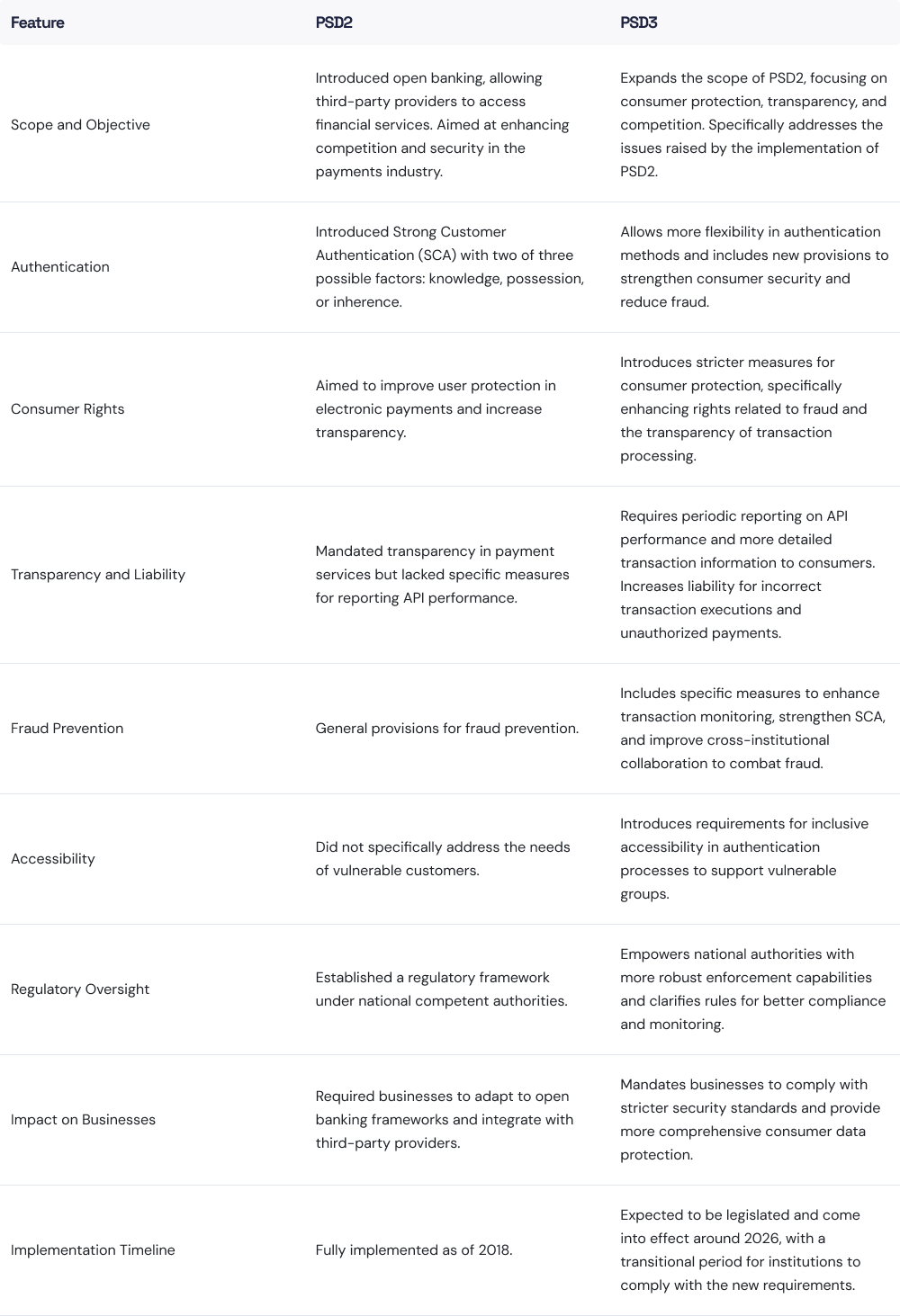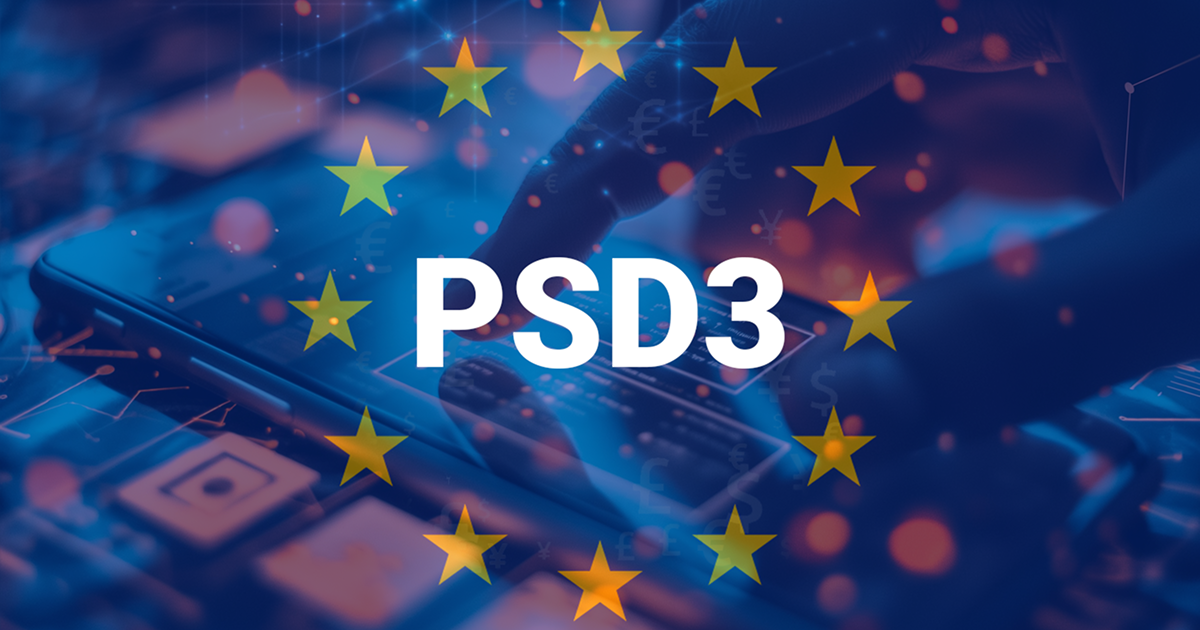blog
April 23, 2024
PSD2 vs. PSD3: The Evolution of Payment Services Regulation
The financial sector is constantly evolving, driven by technological advancements and regulatory changes. The proposed Payment Services Directive 3 (PSD3) demonstrates this dynamic environment, building on its predecessor, PSD2, to address emerging challenges and opportunities within the financial landscape in Europe. This article explores the nuances of PSD3, contrasts it with PSD2, and underscores how banks and fintech businesses can ensure regulatory compliance in the EU market.
Understanding PSD3: An extension of PSD2
PSD3 is not yet fully formalized in law; however, it represents the European Union’s ongoing commitment to creating a more integrated, efficient, and secure financial market. On February 14th, 2024, the European Parliament announced that ECON (its Economic and Monetary Affairs Committee) had adopted draft reports on the European Commission's legislative proposals for a Directive on payment services and electronic money services (PSD3) and a Regulation on payment services in the EU (PSR). Simply put, the EU committee has just endorsed and fast-tracked these major payment reform plans.
To fully appreciate the implications of PSD3, one must first consider the foundation laid by PSD2. Implemented in January 2018, PSD2 aimed to enhance online payment security, foster innovation, and increase competition in the EU financial sector. It introduced key concepts such as Strong Customer Authentication (SCA) and opened banking APIs, which mandated that banks provide third-party providers (TPPs) access to their customers' accounts (with customer consent) to enable more varied financial services.
Where PSD2 opened the door, PSD3 seeks to expand the threshold. The focus shifts toward closing regulatory gaps exposed by PSD2, particularly in areas like security, data management, and cross-border payments. Additionally, PSD3 is expected to tackle issues arising from the increased use and sophistication of artificial intelligence and machine learning in financial services, ensuring that these technologies are employed transparently and ethically.

Key differences between PSD2 and PSD3
While PSD2 broke new ground in regulating payment services, PSD3 is anticipated to refine these regulations with several enhancements:
1. Enhanced Consumer Protection
PSD3 may introduce more stringent measures to protect consumers from fraud, unauthorized transactions, and privacy breaches.
For example, PSD2 mandated Strong Customer Authentication (SCA) which required a two-factor authentication process for online transactions to increase security. PSD3 could go further by implementing advanced monitoring technologies that use machine learning to detect and prevent fraudulent activities in real-time. This could reduce the incidence of sophisticated cybercrimes such as identity theft and unauthorized account access, offering consumers greater peace of mind.
2. Regulation of New Entities
As financial ecosystems evolve, new types of financial entities and technologies that were not previously covered under PSD2 may come under scrutiny in PSD3.
For instance, PSD2 primarily focused on payment service providers and banks, but PSD3 could extend regulations to cover fintech companies offering cryptocurrency services, digital wallets, and peer-to-peer platforms which have become more prominent. This inclusion ensures that all entities handling consumer financial data adhere to strict regulatory standards, maintaining a secure and stable financial environment.
3. Standardization of APIs
While PSD2 encouraged the development of open banking, it led to a fragmented market with varying standards of APIs across banks. PSD3 might push for more standardized APIs to facilitate smoother, more secure interoperability across services and borders.
An example of this could be implementing a unified API framework that all EU banks and financial institutions must adopt, similar to the UK’s Open Banking standards developed by the Competition and Markets Authority. This would enable developers to create applications that can work seamlessly with any bank in the EU without needing to customize integrations for each bank’s unique API, thus fostering innovation and enhancing user experience across the board.


A detailed comparison of the PSD2 and the proposed PSD3

How to transition from PSD2 to PSD3
Transitioning from PSD2 to PSD3 involves several strategic steps for financial institutions and fintech companies across the EU. Here's a structured approach to managing this regulatory shift:
1. Conduct System Audits: Review existing systems to evaluate current compliance with PSD2 and identify areas that require upgrades or adjustments in anticipation of PSD3. Focus on data security, customer authentication processes, and API functionality.
2. Update Policies and Technical Solutions: Modify internal policies and develop technical solutions to meet the expanded requirements of PSD3. This could include implementing advanced fraud detection systems that use artificial intelligence and machine learning to enhance consumer protection.
3. Engage with Regulatory Bodies: Stay informed about PSD3 developments by engaging with regulatory authorities. Participating in industry consultations can provide insights into the regulatory landscape and influence understanding of upcoming changes.
4. Initiate Staff Training Programs: Prepare comprehensive staff training to ensure they understand the implications of PSD3 and how it differs from PSD2. Update operational procedures based on the new requirements.
5. Foster Technological Partnerships: Collaborate with technology providers who have expertise in regulatory transitions. This is crucial for upgrading systems, such as standardizing APIs, to ensure they meet new standards for compatibility and interoperability.
6. Leverage the New Framework: Use the transition as an opportunity to enhance service offerings, capitalizing on the improvements in security and functionality that PSD3 aims to introduce.
By following these steps, institutions can effectively navigate the transition from PSD2 to PSD3, ensuring compliance and taking advantage of the opportunities it presents to improve their services in the digital finance market.

Could PSD3 and API standardization influence the global fintech market?
The standardization of APIs under PSD3 could have several global implications for the fintech market beyond the EU:
1. Facilitation of Cross-Border Services: Standardized APIs can make it easier for companies to offer their services across borders, helping them to expand into new markets with less friction and lower costs of integration.
2. Enhanced Interoperability: With standardized APIs, fintech companies around the world could more easily integrate with European banks and payment services, fostering greater global interoperability in the financial sector.
3. Boost in Innovation: The clear and consistent API standards could lower barriers to entry for new fintech startups, spurring innovation. As more services become compatible with each other, it opens up new possibilities for developing unique solutions that can operate on a global scale.
4. Increased Competition: Standardization might also increase competition globally as non-EU companies could enter the EU market more easily, and EU companies could expand their operations worldwide with fewer technological barriers.
5. Improved Consumer Experience: For consumers, standardized APIs mean more choices, better services, and smoother experiences as companies focus on improving offerings rather than dealing with compatibility and regulatory compliance issues.

Engaging expertise transitioning to PSD3
The transition from PSD2 to PSD3 also highlights a critical need: the expertise of software developers proficient in navigating the regulatory landscape. Here’s why hiring knowledgeable developers is essential for banks and fintech companies:
1. Compliance with complex regulations: The complexity of PSD3 requires developers who not only understand the technical requirements but also grasp the regulatory implications.
2. Implementation of secure APIs: As PSD3 may emphasize standardizing APIs, developers will need to design APIs that meet these standards while ensuring robust security to protect sensitive financial data.
3. Integration of AI and advanced technologies: With the potential increased use of AI and ML under PSD3, developers must be adept at integrating these technologies in a way that complies with ethical standards and regulatory requirements.
With regulatory changes like PSD3, the demand for skilled software developers will only grow. Banks and fintech businesses should invest in this expertise sooner rather than later to stay ahead in a dynamic market. By understanding the changes introduced by PSD3, firms can better prepare to meet these new challenges, ensuring both compliance and innovation.
Blocshop will provide you with a competitive edge when it comes to PSD3
Reach out to Blocshop to explore how our fintech and open banking-focused software development services can enhance your preparations for PSD3 and ensure that you are fully equipped to meet the future with confidence and compliance.
Learn more from our insights
The journey to your
custom software
solution starts here.
Services
blog
April 23, 2024
PSD2 vs. PSD3: The Evolution of Payment Services Regulation
The financial sector is constantly evolving, driven by technological advancements and regulatory changes. The proposed Payment Services Directive 3 (PSD3) demonstrates this dynamic environment, building on its predecessor, PSD2, to address emerging challenges and opportunities within the financial landscape in Europe. This article explores the nuances of PSD3, contrasts it with PSD2, and underscores how banks and fintech businesses can ensure regulatory compliance in the EU market.
Understanding PSD3: An extension of PSD2
PSD3 is not yet fully formalized in law; however, it represents the European Union’s ongoing commitment to creating a more integrated, efficient, and secure financial market. On February 14th, 2024, the European Parliament announced that ECON (its Economic and Monetary Affairs Committee) had adopted draft reports on the European Commission's legislative proposals for a Directive on payment services and electronic money services (PSD3) and a Regulation on payment services in the EU (PSR). Simply put, the EU committee has just endorsed and fast-tracked these major payment reform plans.
To fully appreciate the implications of PSD3, one must first consider the foundation laid by PSD2. Implemented in January 2018, PSD2 aimed to enhance online payment security, foster innovation, and increase competition in the EU financial sector. It introduced key concepts such as Strong Customer Authentication (SCA) and opened banking APIs, which mandated that banks provide third-party providers (TPPs) access to their customers' accounts (with customer consent) to enable more varied financial services.
Where PSD2 opened the door, PSD3 seeks to expand the threshold. The focus shifts toward closing regulatory gaps exposed by PSD2, particularly in areas like security, data management, and cross-border payments. Additionally, PSD3 is expected to tackle issues arising from the increased use and sophistication of artificial intelligence and machine learning in financial services, ensuring that these technologies are employed transparently and ethically.

Key differences between PSD2 and PSD3
While PSD2 broke new ground in regulating payment services, PSD3 is anticipated to refine these regulations with several enhancements:
1. Enhanced Consumer Protection
PSD3 may introduce more stringent measures to protect consumers from fraud, unauthorized transactions, and privacy breaches.
For example, PSD2 mandated Strong Customer Authentication (SCA) which required a two-factor authentication process for online transactions to increase security. PSD3 could go further by implementing advanced monitoring technologies that use machine learning to detect and prevent fraudulent activities in real-time. This could reduce the incidence of sophisticated cybercrimes such as identity theft and unauthorized account access, offering consumers greater peace of mind.
2. Regulation of New Entities
As financial ecosystems evolve, new types of financial entities and technologies that were not previously covered under PSD2 may come under scrutiny in PSD3.
For instance, PSD2 primarily focused on payment service providers and banks, but PSD3 could extend regulations to cover fintech companies offering cryptocurrency services, digital wallets, and peer-to-peer platforms which have become more prominent. This inclusion ensures that all entities handling consumer financial data adhere to strict regulatory standards, maintaining a secure and stable financial environment.
3. Standardization of APIs
While PSD2 encouraged the development of open banking, it led to a fragmented market with varying standards of APIs across banks. PSD3 might push for more standardized APIs to facilitate smoother, more secure interoperability across services and borders.
An example of this could be implementing a unified API framework that all EU banks and financial institutions must adopt, similar to the UK’s Open Banking standards developed by the Competition and Markets Authority. This would enable developers to create applications that can work seamlessly with any bank in the EU without needing to customize integrations for each bank’s unique API, thus fostering innovation and enhancing user experience across the board.


A detailed comparison of the PSD2 and the proposed PSD3

How to transition from PSD2 to PSD3
Transitioning from PSD2 to PSD3 involves several strategic steps for financial institutions and fintech companies across the EU. Here's a structured approach to managing this regulatory shift:
1. Conduct System Audits: Review existing systems to evaluate current compliance with PSD2 and identify areas that require upgrades or adjustments in anticipation of PSD3. Focus on data security, customer authentication processes, and API functionality.
2. Update Policies and Technical Solutions: Modify internal policies and develop technical solutions to meet the expanded requirements of PSD3. This could include implementing advanced fraud detection systems that use artificial intelligence and machine learning to enhance consumer protection.
3. Engage with Regulatory Bodies: Stay informed about PSD3 developments by engaging with regulatory authorities. Participating in industry consultations can provide insights into the regulatory landscape and influence understanding of upcoming changes.
4. Initiate Staff Training Programs: Prepare comprehensive staff training to ensure they understand the implications of PSD3 and how it differs from PSD2. Update operational procedures based on the new requirements.
5. Foster Technological Partnerships: Collaborate with technology providers who have expertise in regulatory transitions. This is crucial for upgrading systems, such as standardizing APIs, to ensure they meet new standards for compatibility and interoperability.
6. Leverage the New Framework: Use the transition as an opportunity to enhance service offerings, capitalizing on the improvements in security and functionality that PSD3 aims to introduce.
By following these steps, institutions can effectively navigate the transition from PSD2 to PSD3, ensuring compliance and taking advantage of the opportunities it presents to improve their services in the digital finance market.

Could PSD3 and API standardization influence the global fintech market?
The standardization of APIs under PSD3 could have several global implications for the fintech market beyond the EU:
1. Facilitation of Cross-Border Services: Standardized APIs can make it easier for companies to offer their services across borders, helping them to expand into new markets with less friction and lower costs of integration.
2. Enhanced Interoperability: With standardized APIs, fintech companies around the world could more easily integrate with European banks and payment services, fostering greater global interoperability in the financial sector.
3. Boost in Innovation: The clear and consistent API standards could lower barriers to entry for new fintech startups, spurring innovation. As more services become compatible with each other, it opens up new possibilities for developing unique solutions that can operate on a global scale.
4. Increased Competition: Standardization might also increase competition globally as non-EU companies could enter the EU market more easily, and EU companies could expand their operations worldwide with fewer technological barriers.
5. Improved Consumer Experience: For consumers, standardized APIs mean more choices, better services, and smoother experiences as companies focus on improving offerings rather than dealing with compatibility and regulatory compliance issues.

Engaging expertise transitioning to PSD3
The transition from PSD2 to PSD3 also highlights a critical need: the expertise of software developers proficient in navigating the regulatory landscape. Here’s why hiring knowledgeable developers is essential for banks and fintech companies:
1. Compliance with complex regulations: The complexity of PSD3 requires developers who not only understand the technical requirements but also grasp the regulatory implications.
2. Implementation of secure APIs: As PSD3 may emphasize standardizing APIs, developers will need to design APIs that meet these standards while ensuring robust security to protect sensitive financial data.
3. Integration of AI and advanced technologies: With the potential increased use of AI and ML under PSD3, developers must be adept at integrating these technologies in a way that complies with ethical standards and regulatory requirements.
With regulatory changes like PSD3, the demand for skilled software developers will only grow. Banks and fintech businesses should invest in this expertise sooner rather than later to stay ahead in a dynamic market. By understanding the changes introduced by PSD3, firms can better prepare to meet these new challenges, ensuring both compliance and innovation.
Blocshop will provide you with a competitive edge when it comes to PSD3
Reach out to Blocshop to explore how our fintech and open banking-focused software development services can enhance your preparations for PSD3 and ensure that you are fully equipped to meet the future with confidence and compliance.
Learn more from our insights
Let's talk!
The journey to your
custom software
solution starts here.
Services
Head Office
Revoluční 1
110 00, Prague Czech Republic
hello@blocshop.io
blog
April 23, 2024
PSD2 vs. PSD3: The Evolution of Payment Services Regulation
The financial sector is constantly evolving, driven by technological advancements and regulatory changes. The proposed Payment Services Directive 3 (PSD3) demonstrates this dynamic environment, building on its predecessor, PSD2, to address emerging challenges and opportunities within the financial landscape in Europe. This article explores the nuances of PSD3, contrasts it with PSD2, and underscores how banks and fintech businesses can ensure regulatory compliance in the EU market.
Understanding PSD3: An extension of PSD2
PSD3 is not yet fully formalized in law; however, it represents the European Union’s ongoing commitment to creating a more integrated, efficient, and secure financial market. On February 14th, 2024, the European Parliament announced that ECON (its Economic and Monetary Affairs Committee) had adopted draft reports on the European Commission's legislative proposals for a Directive on payment services and electronic money services (PSD3) and a Regulation on payment services in the EU (PSR). Simply put, the EU committee has just endorsed and fast-tracked these major payment reform plans.
To fully appreciate the implications of PSD3, one must first consider the foundation laid by PSD2. Implemented in January 2018, PSD2 aimed to enhance online payment security, foster innovation, and increase competition in the EU financial sector. It introduced key concepts such as Strong Customer Authentication (SCA) and opened banking APIs, which mandated that banks provide third-party providers (TPPs) access to their customers' accounts (with customer consent) to enable more varied financial services.
Where PSD2 opened the door, PSD3 seeks to expand the threshold. The focus shifts toward closing regulatory gaps exposed by PSD2, particularly in areas like security, data management, and cross-border payments. Additionally, PSD3 is expected to tackle issues arising from the increased use and sophistication of artificial intelligence and machine learning in financial services, ensuring that these technologies are employed transparently and ethically.

Key differences between PSD2 and PSD3
While PSD2 broke new ground in regulating payment services, PSD3 is anticipated to refine these regulations with several enhancements:
1. Enhanced Consumer Protection
PSD3 may introduce more stringent measures to protect consumers from fraud, unauthorized transactions, and privacy breaches.
For example, PSD2 mandated Strong Customer Authentication (SCA) which required a two-factor authentication process for online transactions to increase security. PSD3 could go further by implementing advanced monitoring technologies that use machine learning to detect and prevent fraudulent activities in real-time. This could reduce the incidence of sophisticated cybercrimes such as identity theft and unauthorized account access, offering consumers greater peace of mind.
2. Regulation of New Entities
As financial ecosystems evolve, new types of financial entities and technologies that were not previously covered under PSD2 may come under scrutiny in PSD3.
For instance, PSD2 primarily focused on payment service providers and banks, but PSD3 could extend regulations to cover fintech companies offering cryptocurrency services, digital wallets, and peer-to-peer platforms which have become more prominent. This inclusion ensures that all entities handling consumer financial data adhere to strict regulatory standards, maintaining a secure and stable financial environment.
3. Standardization of APIs
While PSD2 encouraged the development of open banking, it led to a fragmented market with varying standards of APIs across banks. PSD3 might push for more standardized APIs to facilitate smoother, more secure interoperability across services and borders.
An example of this could be implementing a unified API framework that all EU banks and financial institutions must adopt, similar to the UK’s Open Banking standards developed by the Competition and Markets Authority. This would enable developers to create applications that can work seamlessly with any bank in the EU without needing to customize integrations for each bank’s unique API, thus fostering innovation and enhancing user experience across the board.


A detailed comparison of the PSD2 and the proposed PSD3

How to transition from PSD2 to PSD3
Transitioning from PSD2 to PSD3 involves several strategic steps for financial institutions and fintech companies across the EU. Here's a structured approach to managing this regulatory shift:
1. Conduct System Audits: Review existing systems to evaluate current compliance with PSD2 and identify areas that require upgrades or adjustments in anticipation of PSD3. Focus on data security, customer authentication processes, and API functionality.
2. Update Policies and Technical Solutions: Modify internal policies and develop technical solutions to meet the expanded requirements of PSD3. This could include implementing advanced fraud detection systems that use artificial intelligence and machine learning to enhance consumer protection.
3. Engage with Regulatory Bodies: Stay informed about PSD3 developments by engaging with regulatory authorities. Participating in industry consultations can provide insights into the regulatory landscape and influence understanding of upcoming changes.
4. Initiate Staff Training Programs: Prepare comprehensive staff training to ensure they understand the implications of PSD3 and how it differs from PSD2. Update operational procedures based on the new requirements.
5. Foster Technological Partnerships: Collaborate with technology providers who have expertise in regulatory transitions. This is crucial for upgrading systems, such as standardizing APIs, to ensure they meet new standards for compatibility and interoperability.
6. Leverage the New Framework: Use the transition as an opportunity to enhance service offerings, capitalizing on the improvements in security and functionality that PSD3 aims to introduce.
By following these steps, institutions can effectively navigate the transition from PSD2 to PSD3, ensuring compliance and taking advantage of the opportunities it presents to improve their services in the digital finance market.

Could PSD3 and API standardization influence the global fintech market?
The standardization of APIs under PSD3 could have several global implications for the fintech market beyond the EU:
1. Facilitation of Cross-Border Services: Standardized APIs can make it easier for companies to offer their services across borders, helping them to expand into new markets with less friction and lower costs of integration.
2. Enhanced Interoperability: With standardized APIs, fintech companies around the world could more easily integrate with European banks and payment services, fostering greater global interoperability in the financial sector.
3. Boost in Innovation: The clear and consistent API standards could lower barriers to entry for new fintech startups, spurring innovation. As more services become compatible with each other, it opens up new possibilities for developing unique solutions that can operate on a global scale.
4. Increased Competition: Standardization might also increase competition globally as non-EU companies could enter the EU market more easily, and EU companies could expand their operations worldwide with fewer technological barriers.
5. Improved Consumer Experience: For consumers, standardized APIs mean more choices, better services, and smoother experiences as companies focus on improving offerings rather than dealing with compatibility and regulatory compliance issues.

Engaging expertise transitioning to PSD3
The transition from PSD2 to PSD3 also highlights a critical need: the expertise of software developers proficient in navigating the regulatory landscape. Here’s why hiring knowledgeable developers is essential for banks and fintech companies:
1. Compliance with complex regulations: The complexity of PSD3 requires developers who not only understand the technical requirements but also grasp the regulatory implications.
2. Implementation of secure APIs: As PSD3 may emphasize standardizing APIs, developers will need to design APIs that meet these standards while ensuring robust security to protect sensitive financial data.
3. Integration of AI and advanced technologies: With the potential increased use of AI and ML under PSD3, developers must be adept at integrating these technologies in a way that complies with ethical standards and regulatory requirements.
With regulatory changes like PSD3, the demand for skilled software developers will only grow. Banks and fintech businesses should invest in this expertise sooner rather than later to stay ahead in a dynamic market. By understanding the changes introduced by PSD3, firms can better prepare to meet these new challenges, ensuring both compliance and innovation.
Blocshop will provide you with a competitive edge when it comes to PSD3
Reach out to Blocshop to explore how our fintech and open banking-focused software development services can enhance your preparations for PSD3 and ensure that you are fully equipped to meet the future with confidence and compliance.
Learn more from our insights
Let's talk!
The journey to your
custom software solution starts here.
Services










